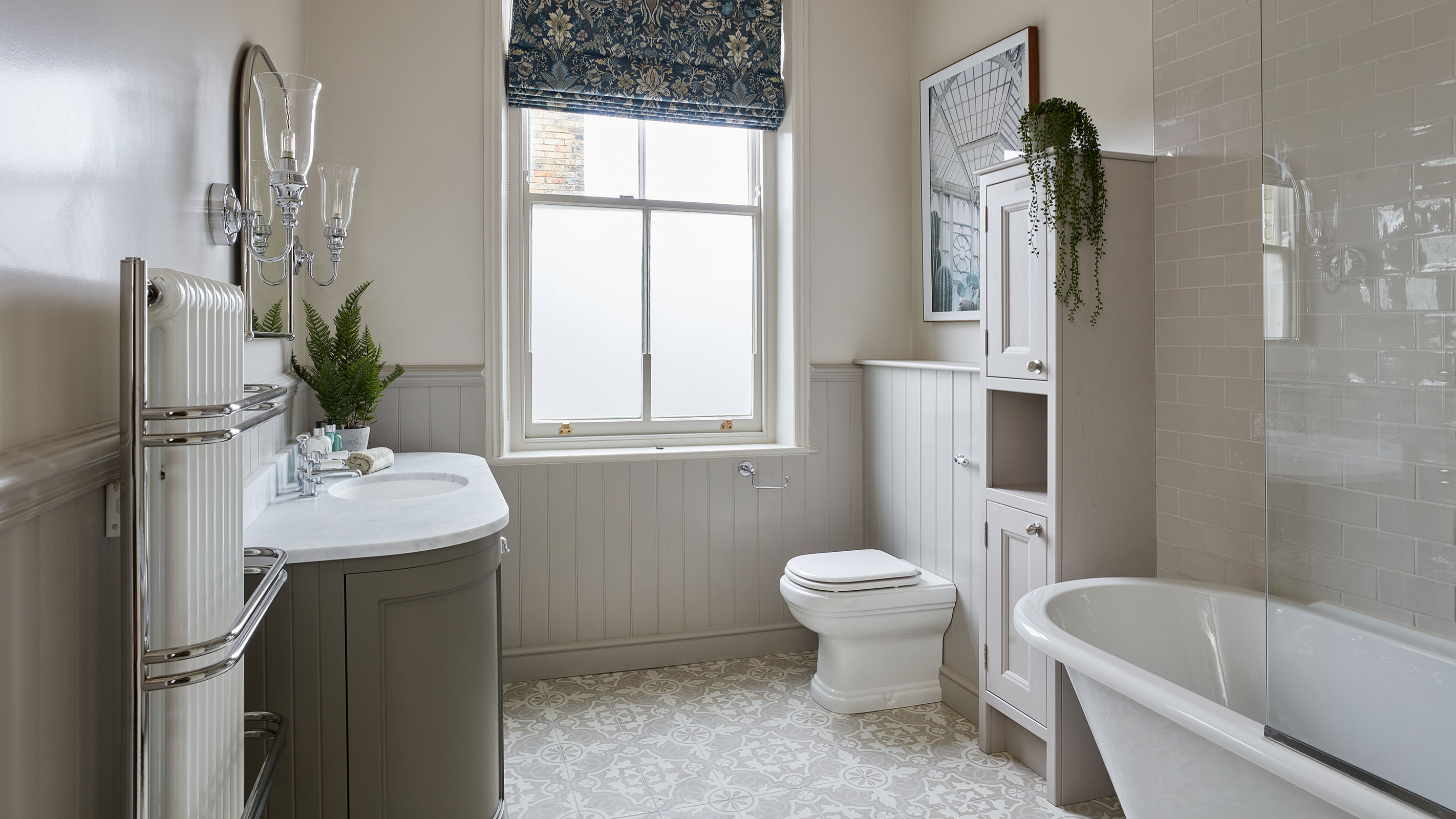Underfloor heating in bathrooms: What are the best options?
If you’re thinking about fitting UFH in your bathroom, we're here to explain the options and installation and running costs involved

Underfloor heating in bathrooms is a popular choice — but how viable is it?
Underfloor heating (UFH) creates an even heat that emanates around a room, from the toes up. It’s like one large underfoot radiator. One problem with installing UFH in a bathroom is that most homeowners also often want a towel radiator — combined, they’re a big investment in a room only used for a small proportion of the day. But the comfort of stepping out of a bath or shower onto a warm floor is often justification enough.
Here, we take a look at the best types of underfloor heating for bathrooms, the options for those wishing to retrofit it in bathroom renovation projects and explain the associated costs — as well as how much it is likely to set you back to run.
What types of underfloor heating are there?
The options for UFH are either wet or electric.
A wet system features pipes that are filled with warm water that’s powered by either a boiler or heat pump. The pipes are concealed within the floor and are more often than not covered by a screed.
In the case of electric underfloor heating, this system consists of wires – either as a system or integrated into matting – that warms up when it’s switched on.
In a new build project, where heating the bathroom is a part of the whole-house heating system, a wet system will offer significantly better running costs than electric systems and the installation cost (as part of a larger system) will be comparable to an electric system. But for retrofit projects, electric systems offer distinct advantages.
Bring your dream home to life with expert advice, how to guides and design inspiration. Sign up for our newsletter and get two free tickets to a Homebuilding & Renovating Show near you.
Installation cost will be lower — £25 to £30/m2 compared to an installed cost of over £45/m2 for wet UFH; their lower profile minimises the impact on ceiling height (less than 10mm), and the weight imposed on the existing floor. Even a low profile wet system is likely to raise the floor level (in a retrofit) by at least 20mm.
In short, in a new build a wet system, with a wet towel radiator, is likely to be preferred and in a retrofit project the electric system, with an electric towel radiator, is likely to be better.
How do you retrofit underfloor heating in a bathroom?
In retrofit situations, underfloor heating installation is not a straightforward job, but it can be done.
The problem is that, unless the existing floor can be taken up and the UFH installed below it, UFH will raise the finished floor level. Even raising the floor level by 10mm (likely to be the case for electric UFH) can be tricky to deal with around baths, shower trays, pedestals and so on. But lifting the floor and installing below it is not easy either.
Then there is insulation to consider. Any UFH system will need insulation below it to encourage the heat into the room above rather than the room below.
There are technically competent DIYers that will successfully take on the job of fitting either system (although sign off from an electrician is needed for dry systems) but generally this is an installation job best left to the professionals.

How much does bathroom underfloor heating cost to install?
Underfloor hating costs vary hugely with the scope of the project but will be disproportionately high if it is just the bathroom being done. For example, one high street retailer offers a 10m2 electric UFH kit for £292 and a 1m2 kit for £59.
The only sensible option is to get three quotes (minimum) for your job. And perhaps get comparative quotes for electric and wet options, if either would work in your space.
How much does underfloor heating cost to run?
It depends, obviously, on how big the bathroom is but also on how well it is insulated.
Assume an ‘average’ bathroom of 10m2 floor area and insulation to current standards. In that case electric UFH is likely to cost around £120 per year and a wet system around £45 per year (assuming a gas boiler).
Bear in mind that the recent massive fluctuations in energy prices means that it is impossible to predict what they might become.
Is underfloor heating or radiators better in bathrooms?
Technically there is no difference between either way of heating a bathroom.
The amount of heat needed in the bathroom is determined by the size and thermal efficiency of that room. It does not affect running costs too much if that heat is delivered by radiators or UFH. The capital cost difference between radiators and wet UFH is also unlikely to make or break the deal.
Some would argue that UFH is a little cheaper to run than radiators while others will argue that it is more expensive to install than radiators. Ultimately this does depend on the existing setup of your home.

What are the other considerations when installing UFH in bathrooms?
The preparation work will make the difference. It’s likely that if you’re renovating a bathroom, it will already have a radiator and installing a larger or a better looking one will be a relatively cheap, easy job.
Installing UFH is likely to involve a lot of preparation — lifting and reinstalling the floor covering, increasing the undercut on doors, working around fixtures. The extent of that work, and the cost, could be the deciding factor.
But perhaps the biggest issue is to ensure that the insulation and airtightness are up to scratch. That will reduce both installation and running costs
Which types of bathroom flooring are best with underfloor heating?
One of the myths around UFH is that the floor covering has to be ceramic tiles or similar. This is not true and you can safely use whatever bathroom flooring you want (within reason).
However, it being a bathroom, ceramic tiles would be a good choice. It must also be noted that the heat output of a UFH system can vary from 50W/m2 to upwards of 200W/m2. The floor construction, the levels of insulation and the floor covering will directly affect the amount of heat getting into the room, and the speed with which it gets there. So it is important that the installer is asked to do the maths and work out how much heat is needed in the bathroom and the required heat output of the UFH system. That calculation will be directly affected by the floor covering. For example, a thin ceramic tile will allow the room to be heated more quickly than a thick ceramic tile but will also cool down more quickly. A wood floor covering will also take more time to heat the room but will cool down gradually.

Tim is an expert in sustainable building methods and energy efficiency in residential homes and writes on the subject for magazines and national newspapers. He is the author of The Sustainable Building Bible, Simply Sustainable Homes and Anaerobic Digestion - Making Biogas - Making Energy: The Earthscan Expert Guide.
His interest in renewable energy and sustainability was first inspired by visits to the Royal Festival Hall heat pump and the Edmonton heat-from-waste projects. In 1979 this initial burst of enthusiasm lead to him trying (and failing) to build a biogas digester to convert pig manure into fuel, at a Kent oast-house, his first conversion project.
Moving in 2002 to a small-holding in South Wales, providing as it did access to a wider range of natural resources, fanned his enthusiasm for sustainability. He went on to install renewable technology at the property, including biomass boiler and wind turbine.
He formally ran energy efficiency consultancy WeatherWorks and was a speaker and expert at the Homebuilding & Renovating Shows across the country.
Tim was an expert in sustainable building methods and energy efficiency in residential homes and wrote on the subject for magazines and national newspapers. He is the author of The Sustainable Building Bible, Simply Sustainable Homes and Anaerobic Digestion - Making Biogas - Making Energy: The Earthscan Expert Guide.
Tim's interest in renewable energy was first inspired by visits to the Royal Festival Hall heat pump and the Edmonton heat-from-waste projects. Moving to a small-holding in South Wales fanned his enthusiasm for sustainability. He went on to install renewable technology at the property, including biomass boiler and wind turbine.
He formally ran energy-efficiency consultancy WeatherWorks and was a speaker and expert at the Homebuilding & Renovating Shows across the country.
